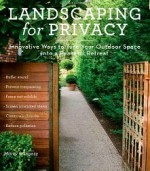 There are many reasons for wanting to create a private place where you can feel safe and get away from the disturbances of daily living. This place may be a small courtyard in an urban setting or a large backyard in the suburbs, the need is the same. The problems in achieving privacy, however, may be very different and Marty Wingate’s book, Landscaping for Privacy, takes a close look at the problems and their possible solutions.
There are many reasons for wanting to create a private place where you can feel safe and get away from the disturbances of daily living. This place may be a small courtyard in an urban setting or a large backyard in the suburbs, the need is the same. The problems in achieving privacy, however, may be very different and Marty Wingate’s book, Landscaping for Privacy, takes a close look at the problems and their possible solutions.
The author focuses on three major ways of achieving privacy; buffers, barriers, and screens. In the chapter on buffers, Wingate shows how buffers can be used to address a variety of problems such as visual and noise nuisances, sun, wind and salt pollution, and providing for children and pets. She points out that a well designed buffer is especially useful for creating the illusion of separation to soften the offensive elements in the landscape and she provides numerous suggestions for creating effective buffers with insets listing suitable plants.
Sometimes a buffer is not enough to create a sense of privacy and a barriers to deter unwanted intrusions of people or animals is necessary. The author points out that although a tall hedge or fence around the perimeter of the property would be a barrier it is not always the best solution to the problem. She believes that “An effective barrier creates a welcoming ambiance while guiding, directing, and instruction” and goes on to suggest that barriers, such as berms, can be implied rather than obvious. Creating berms, selecting fences, and using barriers of various sorts to direct activity are considered with plenty of examples.
Screens are discussed as solutions for unwanted sights ranging from garbage bins to garages. On the other hand, perhaps your house or garden is wide open to peering neighbors. In all these cases a well designed and placed screen can solve the problem and Wingate details how. She cautions against erecting a 30 foot long Leyland cypress or arborvitae hedge to hide an unwanted view because they often cause more problems than they solve. Good screens, according to Wingate, disguise and divert rather than barricade.
The final section of the book presents plant lists. You can find a list for various uses like hedgerows, seaside gardens, and windy sites Some lists are further broken down by region (e.g. Southeast, Mid Atlantic) or by plant type (e.g. conifers for windy sites, broadleaf evergreens for windy sites). Other lists suggest narrow plants, small trees, and vines for trellises. A brief description with light requirements and USDA zone accompanies each named plant.
Landscaping for Privacy provides the basic principles for creating a private retreat with numerous example of each. The many illustrations provide further ideas to inspire the reader and aid him/her analyze the site and decide on the best measures to create a satisfying personal outdoor space. This is not a cookbook and you will not find step by step directions. What you will find is solid basic advice and lots of examples to draw upon so you can make your garden truly your own.